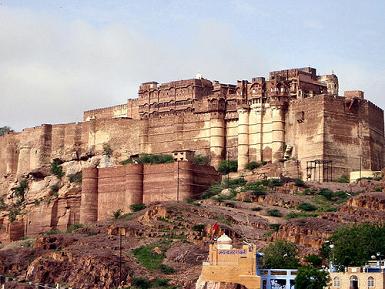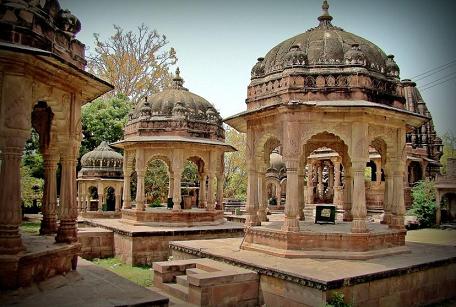
History of jodhpur jodhpur was founded by Rao Jodha whose clan claim to be descendants from Lord Rama. According to history, Nayal Pal established a kingdom at Kannauj that remained the Rathore bastion for more than seven centuries, till they were ousted by Mohammad Ghori. The then ruler Jai Chand died while fleeing and his son Shivaji later founded the Rathore kingdom at Mandore by defeating the Pratiharas. During the British Raj, the state of jodhpur was the largest in Rajputana, by land area. jodhpur prospered under the British Raj. Its merchants, the Marwaris, flourished endlessly. They came to occupy a dominant position in trade throughout India. In 1947 India became independent and the state merged into the union of India. jodhpur became the second city of Rajasthan. The kingdom of jodhpur was ruled by the Rathores, who controlled much of Marwar in western Rajasthan including Bikaner, the other desert fiefdom. The clan traces its lineage back to Rama, the mythical hero of the Hindu epic Ramayana and through him back to the sun god Surya himself. Which is why the Rathores also call themselves Suryavanshi or family of the sun. In modern times, the first Rathore ruler chronicled by history was Nayan Pal, who established his kingdom at Kannauj near modern day Kanpur in Uttar Pradesh in 470 A.D. Here the dynasty flourished until much of north India began to acquire a distinctly Islamic flavour towards the close of the 12th century. Mohammad Ghori the Afghan annexed Kannauj in 1192, forcing the Rathore ruler Raja Jai Chand to flee which he did carrying the Rathore panchranga or the five-coloured flag with him. But dispirited by the defeat he drowned while crossing the Ganges. The Mehrangarh Fort was near invincible and therefore jodhpur was almost immune to enemy attacks though the Mughals and Marathas had their eye on this region. The history of jodhpur took a glorious turn when the Mughal Emperor Akbar became a political ally of jodhpur. In the later years jodhpur signed a treaty with the Marathas and later with the Britishers to be able to maintain its suzerainty. The Rathores enjoyed good relations with all the Mughals, except Aurangzeb. Maharaja Jaswant Singh even supported Shahjahan in his struggle for succession. After Aurangzeb's death, Maharaja Ajit Singh drove out Mughals from Ajmer and added it to Marwar (now jodhpur). Under the reign of Maharaja Umed Singh, jodhpur grew into a fine modern city. The eighteenth century saw many bloody battles between jodhpur and the other princely states in Rajasthan, Jaipur and Udaipur. Ajit Singh's successor Maharaja Abhai Singh captured Ahmedabad and later in 1818, jodhpur signed a treaty with the British. The treaty ensured the kingdom relative peace and prosperity. The last Maharaja before Independence - Umaid Singh after whom the Umaid Bhavan is named - is the grandfather of the present Maharaja Gaj Singh.  Geography of jodhpur : The walled city or old jodhpur has eight gates, of which Jalori Gate and Sojati Gate on the south are the most important the busiest commercial centers surround them. The new city expands to the south and east of the old city. jodhpur history revolves around the Rathore Clan. Rao Jodha, the chief of the Rathore clan, is credited with the origin of jodhpur in India. He founded jodhpur in 1459. The city is named after him only. It was previously known as Marwar. The following paragraphs will tell you more about the past of jodhpur jodhpur Railway station lies to the southwest of Sojati Gate along Station Road. Outside the station three main roads fan out from a statue of a horseman. Olympic Cinema Road to the far left, leads to the telegraph office. The road directly in front of the state leads to the Jalori Gate, which is the best way into the old city. Station Road, leading off to the right towards Sojati Gate, is lined with cheap hotels and restaurants. High Court Road is the main east-West Avenue, running from Sojati Gate past the Umaid Gardens and the Tourist Reception Centre to the distant Raika Bagh Railway Station, just opposite the bus stand, where it bends north towards Paota Circle. Trains from the east stop at the Raika Bagh station, which is before the main station. Nai Sarak, or New Road, leads through Sojati Gate to the biggest shopping thoroughfare and then to the market area, Sadar Bazaar, at the base of the deck tower that marks the centre of jodhpur. The magnificent Meherangarh Fort (above the city) and Jaswant Thada can be seen from almost everywhere. Tourist Places of jodhpur : The famous Places of jodhpur are Mehrangarh Fort, Umaid Bhavan Palace, Jaswant Thada, Mahamandir, Mandore Gardens ,clock tower ,chamunda devi temple and Bal Samand Lake & Palace most tourist attractions of the jodhpur. |

